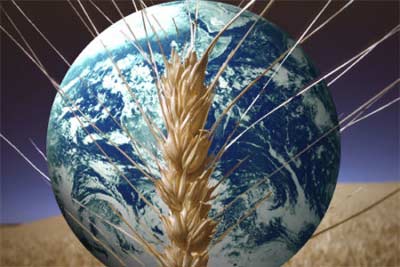14
2013
January 14 2013 |
Food-Price Crisis Signals Imminent Hyperinflation 
Attempting to decipher the global picture regarding food prices, food inventories, and food production is not akin to navigating a labyrinth. A deluge of misleading propaganda and short-term 'noise' from the mainstream media means anyone attempting to decipher these parameters is likely to encounter a plethora of "dead-ends" and "wrong turns." Those following agricultural markets and agricultural prices have seen two, general trends emerging over the past decade: rapidly rising (nominal) prices and steadily falling inventories. This flies directly in the face of the most basic of all supply/demand fundamentals. Yes, falling inventories are supposed to lead to rising prices. However, those rising prices are then supposed to naturally lead to both falling demand (because of higher prices) and rising supply (because of higher prices) – with the rebuilding of inventories an inevitable result. Yet despite the largest price-spike in the price of agricultural commodities in 40 years, inventories remain depressed, and critical stock-to-use ratios remain close to multi-decade lows. So why has the global economy ceased to respond to basic supply/demand stimuli? Because our subsidy-saturated global agriculture model is so absurdly broken.
While fiscally-irresponsible Western governments continue to whine (and do little else) about their exploding debts and deficits, utterly massive (and still-growing) farm subsidies remain untouched. Western agricultural subsidies (direct and indirect) now amount to somewhere in excess of $100 billion/year; however these subsidies are so endemic and heavily-disguised that coming up with an exact figure would be a Herculean task. For example, much of the U.S.'s corn subsidies are in fact listed/described as "ethanol subsidies". The preferential prices (and access) given to U.S. farmers for (precious) water supplies does not even seem to be counted as a "subsidy", despite the tremendous quantities of subsidized water being directed toward (what is now) the U.S.'s "banana economy." U.S. soya bean farmers received nearly $30 billion in "direct subsidies" alone from 1995 – 2011, with subsidized water not even mentioned. There are two obvious and inevitable effects of long-term agriculture subsidies, and long-term subsidies in general: artificially low prices and depressed production. Let me repeat this: the effect of these permanent subsidies on agricultural commodities means that crop prices (and food prices) would have been spiraling upwards even more rapidly otherwise. Put another way, crop prices (and food prices) are not "high" today. Rather, the debauched paper which our bankers (and governments) call "money" has been plummeting in value so rapidly that even with nominal prices spiraling here, in real dollars agriculture prices remain extremely depressed – explaining the relentless, long-term deterioration of inventories. The dynamics are simple. Heavily-subsidized (Western) agricultural products are dumped in markets all over the world. Poorer, less-developed nations cannot compete with those subsidies, and thus subsidized Western agricultural products have bankrupted 10's of millions of small farmers all over the world – and taken that land out of cultivation, further depressing supplies/inventories. Those reactionaries in the U.S. incensed over Mexican "illegal aliens" can thank the "farm lobby" in the U.S. (i.e. Monsanto), as it is 100% responsible for the flood of Mexican migrants into the U.S. Massive corn-subsidies in the U.S. bankrupted millions of Mexican corn-farmers. With no other options for survival, these farmers made their only logical choice: they migrated to the place where they knew that the corn which they used to grow was now being grown – the U.S. Of course, there is a huge difference in the new agricultural model for these Mexican "farmers". Before being bankrupted by U.S. subsidies, they owned-and-farmed their own land; and the profits from that agriculture were their own. Today, they are nothing but subsistence-level slaves for U.S. Agri-Corporations like Monsanto. The numbers are clear. Approximately 95% of U.S. "agricultural workers" are ethnic Mexicans, and more than half of those are "undocumented." This wave of Mexican migrants over the past 20 years has occurred at the same time that U.S. corn-subsidies increased by 300%. Those who claimed that "slavery ended" in the U.S. with the Civil War were obviously premature. The only exception to the steady collapse of the world's vital cereal grains (the key component of the global food supply) has been a sudden reversal of the collapse of global rice inventories. However, this rebound in rice production has come almost exclusively from the frantic increase in rice-planting by Asian governments – fueled by (you guessed it) large, government subsidies. Here Asia's governments are trapped. They did not start the subsidies game. They are not the ones destroying the world's monetary system (and all its currencies) with exponentially-increasing money-printing. Excessive agriculture subsidies are solely the fault of the West, and the reason for those subsidies is solely to hide the collapse in value of the bankers' paper. How high would food prices be without the $100's of billions per year in global, agricultural subsidies? High enough to drop 100's of millions more people below the poverty line (with a growing percentage of that total coming from Western societies), and to put (at least) 10's of millions of the already-poor on a direct path to starvation. The manipulation of the entire global agricultural complex through excessive subsidization and artificially low prices can only have one, possible outcome: a complete collapse of inventories; a global food-availability crisis; and a much, much greater explosion in prices than if there had never been any of this subsidization. Naturally the (corrupt) Corporate Media tells us none of this. It's always "bad weather" here or "drought" there, and rarely any long-term data to provide readers with any sort of clear, overall perspective. However, rarely (if ever) does the entire world experience benign weather for even a single growing-year. And multi-decade lows in inventory levels do not arise from "one drought." Understand the futility of this game. The suppression of global agriculture (and food) prices is intended to hide the total collapse in the value of our paper currencies; because it is the collapse in confidence that such a price-spiral would induce which is the inevitable trigger for hyperinflation. However, with the only possible end-result being an even more-mammoth price-spike, and thus an even more-mammoth collapse in confidence in the bankers' debauched paper; they will inevitably cause the very phenomenon which they are trying (so desperately) to prevent. With the final outcome a mathematical certainty, the only remaining variable is timing. Note too how this gross distortion of agricultural markets has greatly amplified the risk of short-term disruptions to the global food supply. With the U.S. now the world's, great Banana Republic (thanks to massive hand-outs to the Agri-Corporations); the U.S. currently produces roughly 1/3 of the world's corn and soya beans. This absurd over-concentration of global agricultural production in the U.S. not only makes feeding the world highly dependent on the weather of one nation (the U.S.); but makes it equally vulnerable to its corrupt/insane agriculture policies. The obvious example is ethanol, where the ridiculously excessive ethanol subsidies mean that the U.S. currently wastes roughly 40% of its annual corn crop producing the world's most-inefficient (and most heavily-subsidized) bio fuel. Put another way, insane U.S. government ethanol policies by themselves waste more than 10% of total, global corn production. There's still one final dimension of insanity to the subsidy-distorted global food production model. In our modern world, dominated by Western agricultural corporations shipping their products (literally) halfway around the world; roughly ¼ of the global food supply spoils in transit. Obviously without massive Western subsidization, much more of the global food supply would be grown locally. If that were to happen, the percentage of global food production wasted by spoilage in transit would be sure to plummet. Instead, we have the Western Agriculture Model. Countless millions of small farmers bankrupted, and doomed to poverty and/or slavery. Insane/dangerous over-concentration of agricultural production in Western (corporate) agricultural production. An unbelievable percentage of total, global food production completely wasted – as a direct result of Western agricultural imperialism. At the end of it all: the collapse of the global food supply; a massive, global food-supply crisis; and a resulting price-shock for food prices which will doom countless millions to starvation. And after all of that, the bankers' worthless Western currencies are still certain to plummet to zero via the ensuing hyperinflation. |
 |
 |
 |